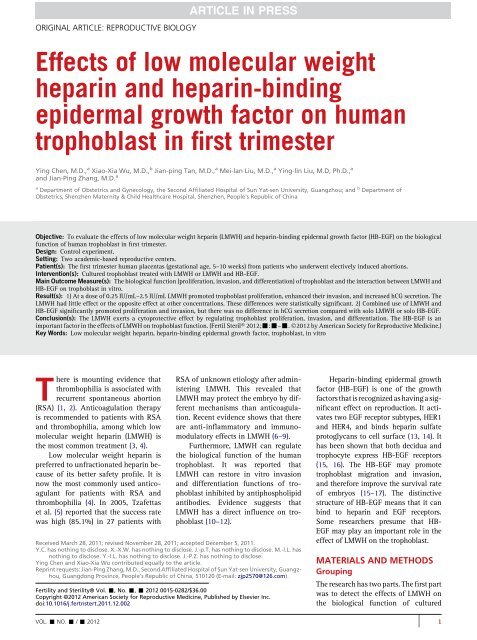Effects of low molecular weight heparin and heparin-binding ...
Effects of low molecular weight heparin and heparin-binding ...
Effects of low molecular weight heparin and heparin-binding ...
You also want an ePaper? Increase the reach of your titles
YUMPU automatically turns print PDFs into web optimized ePapers that Google loves.
Fertility <strong>and</strong> Sterility®DMEM supplemented with 20% FBS at 37 C in an atmospherecontaining 5% CO 2 . After overnight incubation, the mediumwas replaced with DMEM supplemented with 1% FBS foranother 12 hours. Then various concentrations <strong>of</strong> enoxaparin(‘‘clexane,’’ San<strong>of</strong>i-aventis) <strong>and</strong> HB-EGF (R&D Systems) in thepresence <strong>of</strong> DMEM were supplemented for 44 hours. At theend <strong>of</strong> this incubation, 20 mL <strong>of</strong> 93-(4,5-dimethylthiazol-2-yl)2,5-diphenyl tetrazolium bromide (Sigma) (MTT) (5 mg/mL)was added into each well, <strong>and</strong> trophocytes were cultured foran additional 4 hours. Finally, the medium was removed,<strong>and</strong> 150 mL <strong>of</strong> dimethyl sulfoxide (DMSO) was added <strong>and</strong>shaken for 10 minutes. Absorbency was measured at a wavelength<strong>of</strong> 490 nm on an automatic microplate reader. Theabsorbance change was then converted to cell number, basedon a calibration with the known cell number <strong>of</strong> 490 nm. Allexperiments were performed three times or more with freshcultures.Invasion AssayTrophoblast cells were cultured on Matrigel in 6.4-mm transwellinserts with polycarbonate membrane filters containing8-mm pores (Corning). To prepare the gel, 30 mL <strong>of</strong> Matrigel,diluted with DMEM (1:2), was incubated on top <strong>of</strong> the membranesat 37 C <strong>and</strong> the inserts were placed into 24-well cultureplates. After gel formation, trophoblast cells (1 10 5 per well)were added into the upper compartment in 100 mL/well <strong>of</strong>DMEM supplemented with 1% FBS. The LMWH <strong>and</strong> HB-EGFwere added, reaching the presumed final concentration.Then 800 mL <strong>of</strong> DMEM with 10% FBS was added into the <strong>low</strong>ercompartment. The trophoblast cells were incubated at 37 Cinan atmosphere containing 5% CO 2 . After being cultured for 48hours, the cells adhering to the supine surface <strong>of</strong> the uppercompartment were lightly wiped using cotton buds, whereasthe cells migrating to the inferior surface <strong>of</strong> the microporousmembrane were fixed by 4% paraformaldehyde, dyed withFIGURE 2<strong>Effects</strong> <strong>of</strong> <strong>low</strong> <strong>molecular</strong> <strong>weight</strong> <strong>heparin</strong> on trophoblast invasion. The invasive index <strong>of</strong> cells under different conditions was normalized to thecontrol. Microscopic morphologies <strong>of</strong> the invasion <strong>of</strong> trophoblasts through the matrigel-coated membranes were taken at magnification 200.Trophoblast was incubated in the presence <strong>of</strong> 0.025 IU/mL enoxaparin (0.025), 0.25 IU/mL enoxaparin (0.25), 2.5 IU/mL enoxaparin (2.5), 25IU/mL enoxaparin (25), 250 IU/mL enoxaparin (250), <strong>and</strong> control (0).Chen. LMWH <strong>and</strong> HB-EGF on trophoblast. Fertil Steril 2012.VOL. - NO. - / - 2012 3
ORIGINAL ARTICLE: REPRODUCTIVE BIOLOGYhematoxylin <strong>and</strong> mounted with nertrogum. The number <strong>of</strong>cells per pore was counted in five r<strong>and</strong>omly selected fieldswith a microscope. The cell numbers in each pore wereassessed according to Image-Pro Plus 6.0 (Media Cybernetics).All experiments were performed three times or more with freshcultures.FIGURE 3hCG Secretion TestThe hCG secretion test was designed to explore the effects <strong>of</strong>LMWH <strong>and</strong> HB-EGF on trophoblast differentiation. The humantrophoblast cells (3 10 5 per well) were plated out in24-well plates <strong>and</strong> cultured overnight. The LMWH at differentconcentrations <strong>and</strong> HB-EGF in the presence <strong>of</strong> LMWH wereadded to fresh mediums. After incubated for 48 hours thesupernatant was collected <strong>and</strong> stored at 20 C. The concentration<strong>of</strong> b-hCG in the supernatant was determined using thechemiluminescence method. All experiments were performedthree times or more with fresh cultures.Statistical AnalysisAll values were expressed as the mean SD. Data were analyzedusing one-way analysis <strong>of</strong> variance (ANOVA) with theapplication <strong>of</strong> the Dunnett’s test, the least-significant differencetest, <strong>and</strong> a three-factor ANOVA classification. Differenceswere considered as statistically significant at P.05);within the doses <strong>of</strong> 0.25–2.5 IU/mL, LMWH greatly promotedtrophoblast proliferation <strong>and</strong> enhanced their invasion(P
Fertility <strong>and</strong> Sterility®FIGURE 4<strong>Effects</strong> <strong>of</strong> <strong>low</strong> <strong>molecular</strong> <strong>weight</strong> <strong>heparin</strong> (LMWH) <strong>and</strong> <strong>heparin</strong>-<strong>binding</strong> epidermal growth factor (HB-EGF) on trophoblast invasion. The invasive index<strong>of</strong> cells under different conditions was normalized to the control. Microscopic morphologies <strong>of</strong> the invasion <strong>of</strong> trophoblasts through the matrigelcoatedmembranes were taken at magnification 200. Trophoblast was incubated in the presence <strong>of</strong> LMWH (0.25 IU/mL enoxaparin), HB-EGF (10ng/mL HB-EGF), LMWH þ HB-EGF (0.25 IU/mL enoxaparin þ 10 ng/mL HB-EGF), <strong>and</strong> control (Dulbecco’s modified Eagle medium [DMEM]).Chen. LMWH <strong>and</strong> HB-EGF on trophoblast. Fertil Steril 2012.No interaction between LMWH <strong>and</strong> HB-EGF was foundwith regard to hCG secretion when they were simultaneouslyapplied in vitro (P>.05). Compared with the control group, theinhibition <strong>of</strong> solo LMWH on hCG secretion was significant(P
Fertility <strong>and</strong> Sterility®19. Torry DS, Mukherjea D, Arroyo J, Torry RJ. Expression <strong>and</strong> function <strong>of</strong> placentagrowth factor: implications for abnormal placentation. J Soc GynecolInvestig 2003;10:178–88.20. Kaufmann P, Black S, Huppertz B. Endovascular trophoblast invasion:implications for the pathogenesis <strong>of</strong> intrauterine growth retardation <strong>and</strong>preeclampsia. Biol Reprod 2003;69:1–7.21. Erden O, Imir A, Guvenal T, Muslehiddinoglu A, Arici S, Cetin M, et al. Investigation<strong>of</strong> the effects <strong>of</strong> <strong>heparin</strong> <strong>and</strong> <strong>low</strong> <strong>molecular</strong> <strong>weight</strong> <strong>heparin</strong> onE-cadherin <strong>and</strong> laminin expression in rat pregnancy by immunohistochemistry.Hum Reprod 2006;21:3014–8.22. Lei ZM, Rao CV, Ackerman DM, P Licht, ES Hiatt. The expression <strong>of</strong> humanchorionic gonadotropin/human luteinizing hormone receptors in humangestational trophoblastic neoplasms. J Clin Endocrinol Metab 1992;74:1236–41.23. Shi QJ, Lei ZM, Rao CV, Lin J. Novel role <strong>of</strong> human chorionic gonadotropin indifferentiation <strong>of</strong> human cytotrophoblasts. Endocrinology 1993;132:1387–95.24. Licht P, Cao H, Lei ZM, Rao CV, Merz WE. Novel self-regulation <strong>of</strong> humanchorionic gonadotropin biosynthesis in term pregnancy human placenta.Endocrinology 1993;133:3014–25.25. Yagel S, Geva TE, Solomon H, Shimonovitz S, Reich R, Finci Yeheskel Z, et al.High levels <strong>of</strong> human chorionic gonadotropin retard first trimester trophoblastinvasion in vitro by decreasing urokinase plasminogen activator <strong>and</strong>collagenase activities. J Clin Endocrinol Metab 1993;77:1506–11.26. Zygmunt M, McKinnon T, Herr F, Lala PK, Han VK. HCG increases trophoblastmigration in vitro via the insulin-like growth factor-II/mannose-6 phosphatereceptor. Mol Hum Reprod 2005;11:261–7.27. Lala PK, Chakraborty C. Factors regulating trophoblast migration <strong>and</strong> invasiveness:possible derangements contributing to pre-eclampsia <strong>and</strong> fetal injury.Placenta 2003;24:575–87.28. Fisher DA, Lakshmanan J. Metabolism <strong>and</strong> effects <strong>of</strong> epidermal growth factor<strong>and</strong> related growth factors in mammals. Endocrinol Rev 1990;11:418–42.VOL. - NO. - / - 2012 7



